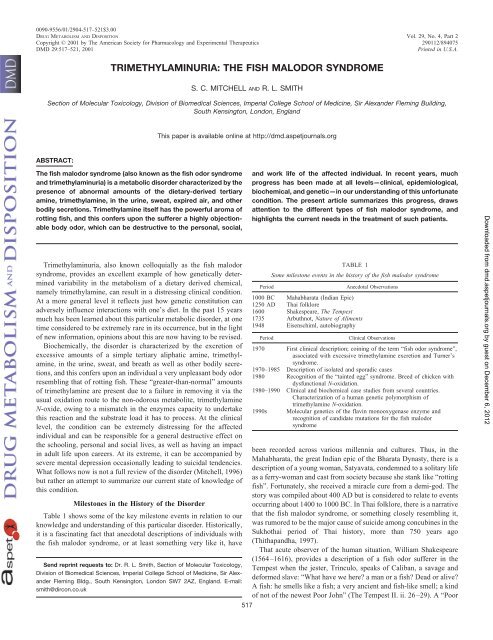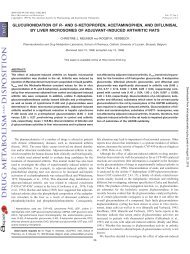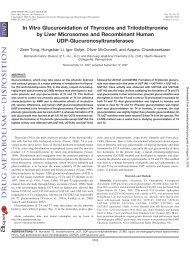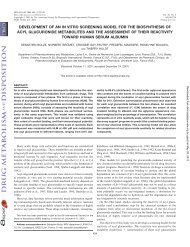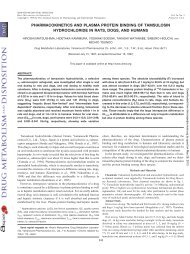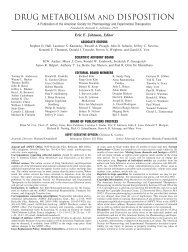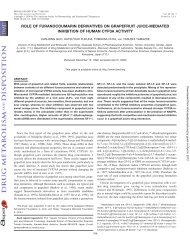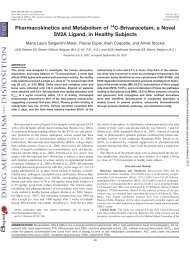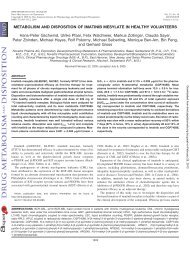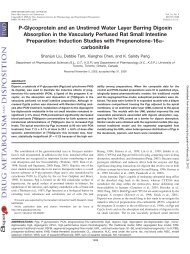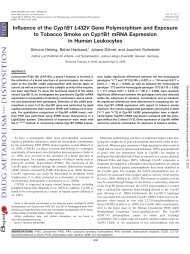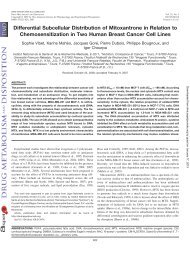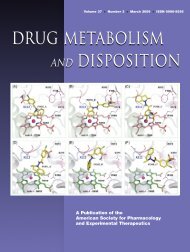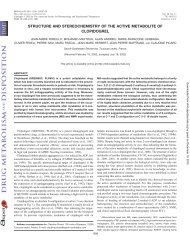trimethylaminuria: the fish malodor syndrome - Drug Metabolism and ...
trimethylaminuria: the fish malodor syndrome - Drug Metabolism and ...
trimethylaminuria: the fish malodor syndrome - Drug Metabolism and ...
You also want an ePaper? Increase the reach of your titles
YUMPU automatically turns print PDFs into web optimized ePapers that Google loves.
0090-9556/01/2904-517–521$3.00<br />
DRUG METABOLISM AND DISPOSITION Vol. 29, No. 4, Part 2<br />
Copyright © 2001 by The American Society for Pharmacology <strong>and</strong> Experimental Therapeutics 290112/894075<br />
DMD 29:517–521, 2001 Printed in U.S.A.<br />
TRIMETHYLAMINURIA: THE FISH MALODOR SYNDROME<br />
S. C. MITCHELL AND R. L. SMITH<br />
Section of Molecular Toxicology, Division of Biomedical Sciences, Imperial College School of Medicine, Sir Alex<strong>and</strong>er Fleming Building,<br />
South Kensington, London, Engl<strong>and</strong><br />
ABSTRACT:<br />
The <strong>fish</strong> <strong>malodor</strong> <strong>syndrome</strong> (also known as <strong>the</strong> <strong>fish</strong> odor <strong>syndrome</strong><br />
<strong>and</strong> <strong>trimethylaminuria</strong>) is a metabolic disorder characterized by <strong>the</strong><br />
presence of abnormal amounts of <strong>the</strong> dietary-derived tertiary<br />
amine, trimethylamine, in <strong>the</strong> urine, sweat, expired air, <strong>and</strong> o<strong>the</strong>r<br />
bodily secretions. Trimethylamine itself has <strong>the</strong> powerful aroma of<br />
rotting <strong>fish</strong>, <strong>and</strong> this confers upon <strong>the</strong> sufferer a highly objectionable<br />
body odor, which can be destructive to <strong>the</strong> personal, social,<br />
Trimethylaminuria, also known colloquially as <strong>the</strong> <strong>fish</strong> <strong>malodor</strong><br />
<strong>syndrome</strong>, provides an excellent example of how genetically determined<br />
variability in <strong>the</strong> metabolism of a dietary derived chemical,<br />
namely trimethylamine, can result in a distressing clinical condition.<br />
At a more general level it reflects just how genetic constitution can<br />
adversely influence interactions with one’s diet. In <strong>the</strong> past 15 years<br />
much has been learned about this particular metabolic disorder, at one<br />
time considered to be extremely rare in its occurrence, but in <strong>the</strong> light<br />
of new information, opinions about this are now having to be revised.<br />
Biochemically, <strong>the</strong> disorder is characterized by <strong>the</strong> excretion of<br />
excessive amounts of a simple tertiary aliphatic amine, trimethylamine,<br />
in <strong>the</strong> urine, sweat, <strong>and</strong> breath as well as o<strong>the</strong>r bodily secretions,<br />
<strong>and</strong> this confers upon an individual a very unpleasant body odor<br />
resembling that of rotting <strong>fish</strong>. These “greater-than-normal” amounts<br />
of trimethylamine are present due to a failure in removing it via <strong>the</strong><br />
usual oxidation route to <strong>the</strong> non-odorous metabolite, trimethylamine<br />
N-oxide, owing to a mismatch in <strong>the</strong> enzymes capacity to undertake<br />
this reaction <strong>and</strong> <strong>the</strong> substrate load it has to process. At <strong>the</strong> clinical<br />
level, <strong>the</strong> condition can be extremely distressing for <strong>the</strong> affected<br />
individual <strong>and</strong> can be responsible for a general destructive effect on<br />
<strong>the</strong> schooling, personal <strong>and</strong> social lives, as well as having an impact<br />
in adult life upon careers. At its extreme, it can be accompanied by<br />
severe mental depression occasionally leading to suicidal tendencies.<br />
What follows now is not a full review of <strong>the</strong> disorder (Mitchell, 1996)<br />
but ra<strong>the</strong>r an attempt to summarize our current state of knowledge of<br />
this condition.<br />
Milestones in <strong>the</strong> History of <strong>the</strong> Disorder<br />
Table 1 shows some of <strong>the</strong> key milestone events in relation to our<br />
knowledge <strong>and</strong> underst<strong>and</strong>ing of this particular disorder. Historically,<br />
it is a fascinating fact that anecdotal descriptions of individuals with<br />
<strong>the</strong> <strong>fish</strong> <strong>malodor</strong> <strong>syndrome</strong>, or at least something very like it, have<br />
Send reprint requests to: Dr. R. L. Smith, Section of Molecular Toxicology,<br />
Division of Biomedical Sciences, Imperial College School of Medicine, Sir Alex<strong>and</strong>er<br />
Fleming Bldg., South Kensington, London SW7 2AZ, Engl<strong>and</strong>. E-mail:<br />
smith@dircon.co.uk<br />
This paper is available online at http://dmd.aspetjournals.org<br />
517<br />
<strong>and</strong> work life of <strong>the</strong> affected individual. In recent years, much<br />
progress has been made at all levels—clinical, epidemiological,<br />
biochemical, <strong>and</strong> genetic—in our underst<strong>and</strong>ing of this unfortunate<br />
condition. The present article summarizes this progress, draws<br />
attention to <strong>the</strong> different types of <strong>fish</strong> <strong>malodor</strong> <strong>syndrome</strong>, <strong>and</strong><br />
highlights <strong>the</strong> current needs in <strong>the</strong> treatment of such patients.<br />
TABLE 1<br />
Some milestone events in <strong>the</strong> history of <strong>the</strong> <strong>fish</strong> <strong>malodor</strong> <strong>syndrome</strong><br />
Period Anecdotal Observations<br />
1000 BC Mahabharata (Indian Epic)<br />
1250 AD Thai folklore<br />
1600 Shakespeare, The Tempest<br />
1735 Arbuthnot, Nature of Aliments<br />
1948 Eisenschiml, autobiography<br />
Period Clinical Observations<br />
1970 First clinical description; coining of <strong>the</strong> term “<strong>fish</strong> odor <strong>syndrome</strong>”,<br />
associated with excessive trimethylamine excretion <strong>and</strong> Turner’s<br />
<strong>syndrome</strong>.<br />
1970–1985 Description of isolated <strong>and</strong> sporadic cases<br />
1980 Recognition of <strong>the</strong> “tainted egg” <strong>syndrome</strong>. Breed of chicken with<br />
dysfunctional N-oxidation.<br />
1980–1990 Clinical <strong>and</strong> biochemical case studies from several countries.<br />
Characterization of a human genetic polymorphism of<br />
trimethylamine N-oxidation.<br />
1990s Molecular genetics of <strong>the</strong> flavin monooxygenase enzyme <strong>and</strong><br />
recognition of c<strong>and</strong>idate mutations for <strong>the</strong> <strong>fish</strong> <strong>malodor</strong><br />
<strong>syndrome</strong><br />
been recorded across various millennia <strong>and</strong> cultures. Thus, in <strong>the</strong><br />
Mahabharata, <strong>the</strong> great Indian epic of <strong>the</strong> Bharata Dynasty, <strong>the</strong>re is a<br />
description of a young woman, Satyavata, condemned to a solitary life<br />
as a ferry-woman <strong>and</strong> cast from society because she stank like “rotting<br />
<strong>fish</strong>”. Fortunately, she received a miracle cure from a demi-god. The<br />
story was compiled about 400 AD but is considered to relate to events<br />
occurring about 1400 to 1000 BC. In Thai folklore, <strong>the</strong>re is a narrative<br />
that <strong>the</strong> <strong>fish</strong> <strong>malodor</strong> <strong>syndrome</strong>, or something closely resembling it,<br />
was rumored to be <strong>the</strong> major cause of suicide among concubines in <strong>the</strong><br />
Sukhothai period of Thai history, more than 750 years ago<br />
(Thithap<strong>and</strong>ha, 1997).<br />
That acute observer of <strong>the</strong> human situation, William Shakespeare<br />
(1564–1616), provides a description of a <strong>fish</strong> odor sufferer in <strong>the</strong><br />
Tempest when <strong>the</strong> jester, Trinculo, speaks of Caliban, a savage <strong>and</strong><br />
deformed slave: “What have we here? a man or a <strong>fish</strong>? Dead or alive?<br />
A <strong>fish</strong>: he smells like a <strong>fish</strong>; a very ancient <strong>and</strong> <strong>fish</strong>-like smell; a kind<br />
of not of <strong>the</strong> newest Poor John” (The Tempest II. ii. 26–29). A “Poor<br />
Downloaded from<br />
dmd.aspetjournals.org by guest on December 6, 2012
518 TRIMETHYLAMINURIA: THE FISH MALODOR SYNDROME<br />
John” in Elizabethan society was a salted <strong>and</strong> dried hake. Incidentally,<br />
Shakespeare also describes Caliban as of a melancholic disposition; a<br />
feature not unusual in some patients with <strong>the</strong> <strong>fish</strong> <strong>malodor</strong> <strong>syndrome</strong>.<br />
A century later, John Arbuthnot (1667–1735), a ma<strong>the</strong>matician <strong>and</strong><br />
physician, wrote in his treatise on nutrition <strong>and</strong> foods, “The oils with<br />
which <strong>fish</strong>es abound often turn rancid, <strong>and</strong> lie heavy on <strong>the</strong> stomach,<br />
<strong>and</strong> affect <strong>the</strong> very sweat with a rancid smell, which is found to be true<br />
in some places, where <strong>the</strong> inhabitants live entirely upon <strong>fish</strong>” (Arbuthnot,<br />
1735). Were <strong>the</strong>se cases of <strong>fish</strong> <strong>malodor</strong> <strong>syndrome</strong>?<br />
Two suspicious reports made <strong>the</strong>ir way into <strong>the</strong> medical literature<br />
around <strong>the</strong> middle of <strong>the</strong> 19th century. One concerns a middle-aged<br />
man who was “attacked by a complicated disorder of <strong>the</strong> digestive<br />
system” <strong>and</strong> <strong>the</strong> “symptom which gave most annoyance was <strong>the</strong><br />
exhalation of a fetid odour from all <strong>the</strong> surface of his body, which<br />
supervened an hour or two after each meal. The patient paid a<br />
scrupulous regard to cleanliness <strong>and</strong> had tried various remedia without<br />
success”. (Anonymous, 1842). The o<strong>the</strong>r report concerned a patient<br />
with “foetid breath <strong>and</strong> its allied annoyance, foetid perspiration” to<br />
which <strong>the</strong> physician recommended <strong>the</strong> “avoidance of strong-smelling<br />
articles of <strong>the</strong> diet including, among many o<strong>the</strong>rs, fried <strong>fish</strong>” (Pidduck,<br />
1858). These appear to be descriptions of <strong>the</strong> <strong>fish</strong> <strong>malodor</strong> <strong>syndrome</strong>.<br />
In <strong>the</strong> 20th century <strong>the</strong>re is reference to a curious case, which in all<br />
likelihood was <strong>the</strong> <strong>fish</strong> <strong>malodor</strong> <strong>syndrome</strong>, in <strong>the</strong> autobiography,<br />
“Without Fame; The Romance of a Profession” by <strong>the</strong> chemist Otto<br />
Eisenschiml. During a period of his career he took up private cosmetic<br />
formulation work <strong>and</strong> in respect to this he writes, “My studies in<br />
human perspiration stood me in good stead later in my consulting<br />
work. Once a physician called on me to get my advice on a peculiar<br />
case he was treating. His patient was a woman of considerable means<br />
whose body odour was so strong that she had become morbid about it.<br />
She would not leave her apartment, shunned visitors, <strong>and</strong> was threatened<br />
with melancholy unless a remedy could be found for her affliction”<br />
(Eisenschiml, 1948). Once again such behavior is not uncommon<br />
in patients with <strong>the</strong> <strong>fish</strong> <strong>malodor</strong> <strong>syndrome</strong>.<br />
The First Clinical Reports<br />
The first clinical description of a case of <strong>fish</strong> <strong>malodor</strong> <strong>syndrome</strong> is<br />
attributed Humbert <strong>and</strong> colleagues (1970). The patient was a 6-yearold<br />
girl with a history of multiple pulmonary infections since <strong>the</strong><br />
neonatal period. The child had <strong>the</strong> clinical stigmata of Turner’s<br />
<strong>syndrome</strong>, splenomegaly, mild anemia <strong>and</strong> neutropenia, abnormal<br />
platelet function, <strong>and</strong> decreased deformability of <strong>the</strong> red cells. Her<br />
mo<strong>the</strong>r related that <strong>the</strong> child intermittently had a peculiar “<strong>fish</strong>y<br />
odour”. This triggered off a search for trimethylamine, which was<br />
known to smell of <strong>fish</strong>. Biochemical studies following an oral challenge<br />
dose of trimethylamine showed that <strong>the</strong>re was a marked increase<br />
in <strong>the</strong> excretion of <strong>the</strong> free amine in her urine as well as a pronounced<br />
exacerbation of her odor problem. Three healthy controls did not show<br />
<strong>the</strong>se increases (Humbert et al., 1970). A subsequent study on a biopsy<br />
liver sample taken from this patient revealed a defective trimethylamine<br />
N-oxidizing system; <strong>the</strong> defect manifested itself in a Km value<br />
for trimethylamine that was five times higher than that typical of o<strong>the</strong>r<br />
normal “preparations” (Higgins et al., 1972). Over subsequent years,<br />
<strong>the</strong>re appeared a number of sporadic reports of <strong>the</strong> <strong>fish</strong> <strong>malodor</strong><br />
<strong>syndrome</strong> in both adults (Spellacy et al., 1979) <strong>and</strong> young children<br />
(Lee et al., 1976). These early studies showed that <strong>the</strong> condition could<br />
affect infants, children, <strong>and</strong> adults, <strong>and</strong> it was confirmed to be associated<br />
with <strong>the</strong> excretion of excessive amounts of trimethylamine,<br />
sometimes on a sporadic basis. Earlier thinking had associated <strong>fish</strong><br />
<strong>malodor</strong> <strong>syndrome</strong> with Turner’s <strong>and</strong> Noonan’s <strong>syndrome</strong>s but subsequent<br />
experience showed that this was incorrect.<br />
Recognition of <strong>the</strong> “Tainted Egg Syndrome” in Chickens<br />
A fur<strong>the</strong>r significant milestone in <strong>the</strong> evolution of our underst<strong>and</strong>ing<br />
of <strong>the</strong> <strong>fish</strong> <strong>malodor</strong> <strong>syndrome</strong> were <strong>the</strong> studies that showed that a<br />
certain breed of chicken carried an inherited defect in <strong>the</strong> N-oxidation<br />
of trimethylamine. These studies triggered an inquiry into <strong>the</strong> possible<br />
polymorphism of N-oxidation of trimethylamine in humans on <strong>the</strong><br />
simplistic assumption that if it is found in an animal species, it may<br />
well be found in humans. Experience had shown that a certain breed<br />
of Rhode Isl<strong>and</strong> Red chicken produced eggs that were “tainted” due to<br />
<strong>the</strong> presence of trimethylamine, <strong>and</strong> customers were reluctant to<br />
purchase <strong>the</strong>se for obvious reasons. These studies showed that <strong>the</strong><br />
<strong>fish</strong>y contamination associated with “tainters” was due to an inherited<br />
impairment of <strong>the</strong> hens’ ability to N-oxidize trimethylamine to its<br />
N-oxide, coupled with <strong>the</strong> consumption of a diet (rape seed meal) rich<br />
in precursors of trimethylamine (Pearson et al., 1979). Fur<strong>the</strong>rmore, it<br />
was demonstrated that <strong>the</strong> capacity of <strong>the</strong> fowl for trimethylamine<br />
N-oxidation was an inherited trait <strong>and</strong> was consistent with <strong>the</strong> involvement<br />
of a single, autosomal, semidominant gene (Pearson <strong>and</strong><br />
Butler, 1983).<br />
The Search for a Human Genetic Polymorphism of<br />
Trimethylamine N-Oxidation<br />
A population <strong>and</strong> pedigree study confirmed that <strong>the</strong> N-oxidation of<br />
trimethylamine in a White Caucasian population was under genetic<br />
control <strong>and</strong> displayed polymorphism (Al-Waiz et al., 1987). This<br />
study of a r<strong>and</strong>om British white population group (n � 169) showed<br />
that <strong>the</strong> ability to N-oxidize trimethylamine derived from <strong>the</strong> diet was<br />
skewed in terms of <strong>the</strong> population distribution. Based upon a metabolic<br />
ratio of urinary trimethylamine/trimethylamine N-oxide, metabolic<br />
“outliers” could be discerned. Patients diagnosed with <strong>fish</strong><br />
<strong>malodor</strong> <strong>syndrome</strong> occupied one extreme of <strong>the</strong> distribution, <strong>and</strong><br />
pedigree studies involving <strong>the</strong> use of an oral trimethylamine challenge<br />
test (Al-Waiz et al., 1989) revealed that <strong>the</strong> parents could be identified<br />
as carriers or heterozygotes for dysfunctional N-oxidation. Heterozygotes<br />
show clear evidence of limited N-oxidation capacity when<br />
challenged with oral doses (600 mg) of trimethylamine but not with<br />
lower doses. Although <strong>the</strong> test is somewhat unpleasant for <strong>the</strong> subject,<br />
<strong>the</strong> procedure has been found invaluable for <strong>the</strong> characterization of<br />
heterozygotes. This study suggested an incidence of about 1% of<br />
heterozygotes in <strong>the</strong> British Caucasian population with a degree of<br />
uncertainty. A subsequent larger investigation of British subjects (n �<br />
421) confirmed <strong>the</strong>se conclusions <strong>and</strong> verified that <strong>the</strong> N-oxidation of<br />
dietary-derived trimethylamine showed a discontinuous distribution<br />
<strong>and</strong> that about 1% of <strong>the</strong> population was of possible carrier status.<br />
Interestingly this study showed an over-representation of women in<br />
<strong>the</strong> affected group <strong>and</strong> this will be remarked upon later (Zhang et al.,<br />
1996a).<br />
Biochemical Features of Fish Malodor Syndrome<br />
The outst<strong>and</strong>ing biochemical feature in <strong>the</strong> <strong>fish</strong> <strong>malodor</strong> <strong>syndrome</strong><br />
is <strong>the</strong> excessive excretion in <strong>the</strong> urine of un-oxidized trimethylamine.<br />
British individuals on <strong>the</strong> average Western diet excrete in <strong>the</strong> urine<br />
daily about 50 mg of trimethylamine N-oxide <strong>and</strong> about 1 to 2 mg of<br />
free trimethylamine; that is, <strong>the</strong> N-oxide accounts for greater than 90%<br />
of <strong>the</strong> total daily excretion of trimethylamine-related material. The<br />
total amounts vary, however, according to <strong>the</strong> composition of <strong>the</strong> diet<br />
<strong>and</strong> particularly if marine <strong>fish</strong> are eaten because <strong>the</strong>y contain high<br />
levels of trimethylamine N-oxide.<br />
Table 2 shows a summary of <strong>the</strong> pattern of urinary excretion of<br />
trimethylamine <strong>and</strong> its N-oxide for a group of unaffected controls,<br />
known heterozygotes (parents of children with <strong>fish</strong> <strong>malodor</strong> syn-<br />
Downloaded from<br />
dmd.aspetjournals.org by guest on December 6, 2012
TABLE 2<br />
N-Oxidation of trimethylamine in <strong>fish</strong> <strong>malodor</strong> patients, heterozygotes (carriers),<br />
<strong>and</strong> unaffected individuals following a normal diet <strong>and</strong> a 600-mg trimethylamine<br />
oral challenge dose<br />
Results are expressed as <strong>the</strong> mean � S.D. Ranges are given in paren<strong>the</strong>ses.<br />
Group<br />
Following a Normal Diet<br />
Free Trimethylamine as a<br />
Percentage of Total Excretion<br />
Trimethylamine/<br />
N-Oxide Ratio<br />
Fish <strong>malodor</strong><br />
Males � 4 78.5 � 13.3 (59–89) 3.65<br />
Females � 9 71.8 � 15.7 (46–90) 2.55<br />
Heterozygotes (n � 13) 4.5 � 1.8 (2–8) 0.047<br />
Unaffected controls (n � 75) 4.3 � 2.5 (2–9) 0.045<br />
Group<br />
Following a 600-mg Challenge Dose<br />
Free Trimethylamine as a<br />
Percentage of Total Excretion<br />
Trimethylamine/<br />
N-Oxide Ratio<br />
Fish <strong>malodor</strong><br />
Males � 4 91.5 � 5.1 (84–95) 10.76<br />
Females � 6 85.8 � 7.1 (77–93) 6.04<br />
Heterozygotes (n � 13) 24.5 � 2.7 (21–29) 0.32<br />
Unaffected controls (n � 75) 6.6 � 3.0 (1–13) 0.071<br />
drome), <strong>and</strong> some patients with <strong>the</strong> <strong>fish</strong> <strong>malodor</strong> <strong>syndrome</strong>. The<br />
results are expressed as a percentage of <strong>the</strong> total trimethylaminerelated<br />
material excreted in <strong>the</strong> urine as <strong>the</strong> free amine on a normal<br />
diet as well as after an oral challenge “load” test (600 mg of trimethylamine).<br />
The finding for <strong>the</strong> two groups are also expressed in terms<br />
of <strong>the</strong> ratio: percentage trimethylamine/percentage trimethylamine<br />
N-oxide, which is diagnostic for a deficiency of N-oxidation. It can be<br />
seen that both <strong>the</strong> male <strong>and</strong> female patients excrete most (circa<br />
70–80%) of <strong>the</strong> total trimethylamine derived from <strong>the</strong> diet as <strong>the</strong> free<br />
amine compared with only 4% found for healthy controls. The dysfunctional<br />
N-oxidation is clearly reflected in <strong>the</strong> high values seen for<br />
<strong>the</strong> ratio. After <strong>the</strong> challenge test, <strong>the</strong> <strong>fish</strong> <strong>malodor</strong> patients excreted<br />
even more free amine (circa 90%) whereas this remained unaffected<br />
for <strong>the</strong> control subjects. The heterozygotes, who coped with <strong>the</strong><br />
normal dietary input <strong>and</strong> were indistinguishable from <strong>the</strong> unaffected<br />
controls, were shown to falter when challenged with <strong>the</strong> 600-mg oral<br />
load, <strong>and</strong> <strong>the</strong>ir N-oxidation capacities decreased; this is <strong>the</strong> basis of <strong>the</strong><br />
challenge test for heterozygotes or carriers mentioned previously.<br />
In our experience <strong>the</strong>re appears to be a threshold for <strong>the</strong> appearance<br />
of <strong>fish</strong> <strong>malodor</strong> symptoms. The loss of “larger-than-normal” amounts<br />
of trimethylamine via <strong>the</strong> sweat <strong>and</strong> breath appears to occur in<br />
concordance with a urinary level of free trimethylamine of 10 �g/ml<br />
(18–20 �mol/mmol creatinine) or above. Depending upon urinary<br />
volumes, this correlates with a urinary trimethylamine output of about<br />
15 to 20 mg/day.<br />
The intriguing question remains as to whe<strong>the</strong>r or not <strong>the</strong>re are o<strong>the</strong>r<br />
endogenous or dietary substrates whose metabolism is also affected in<br />
<strong>the</strong> <strong>fish</strong> <strong>malodor</strong> <strong>syndrome</strong>. Bearing in mind that many sulfur <strong>and</strong><br />
basic nitrogenous compounds are substrates for <strong>the</strong> enzyme system<br />
involved, this appears to be highly likely but <strong>the</strong> question remains<br />
unanswered as yet.<br />
Incidence of Fish Malodor Syndrome<br />
A question that is frequently asked is what is <strong>the</strong> incidence of <strong>the</strong><br />
<strong>fish</strong> <strong>malodor</strong> <strong>syndrome</strong>? This cannot be answered with any certainty<br />
as new cases are continually being recognized because of a greater<br />
awareness of this metabolic problem. In terms of frequency of occurrence,<br />
it appears that it should no longer be regarded as a “rare”<br />
disorder but more appropriately as an “uncommon” one. As of <strong>the</strong><br />
present, it would seem that well over 200 cases of <strong>the</strong> condition have<br />
MITCHELL AND SMITH<br />
TABLE 3<br />
Data available on <strong>the</strong> occurrence of <strong>the</strong> <strong>fish</strong> <strong>malodor</strong> <strong>syndrome</strong><br />
Country Number of Patients Male Female<br />
United States 102 33 69<br />
United Kingdom 50 22 38<br />
Canada 20<br />
Australia 20<br />
Thail<strong>and</strong> 5 1 4<br />
Israel 2 0 2<br />
Italy 1 1 0<br />
been described on a world-wide basis, <strong>and</strong> this figure is almost<br />
certainly underestimated (Table 3).<br />
The information available to date shows that <strong>the</strong> metabolic <strong>syndrome</strong><br />
has been found in several countries, <strong>and</strong> <strong>the</strong> bias at <strong>the</strong> moment<br />
seems to be in favor of those areas that have populations derived from<br />
British/Scottish/Irish descent, but this leaning is probably more apparent<br />
than real. The condition has been observed in both males <strong>and</strong><br />
females, although overall <strong>the</strong>re appears to have been a preponderance<br />
of females reported with this condition.<br />
Types of Fish Malodor Syndrome<br />
With <strong>the</strong> uncovering of many more cases of <strong>the</strong> <strong>fish</strong> <strong>malodor</strong><br />
<strong>syndrome</strong>, it has become apparent that <strong>the</strong>re are several different types<br />
of this disorder <strong>and</strong> that <strong>the</strong>re is a need to develop a more adequate<br />
system of classification. One is proposed below based on presently<br />
available data. In principle, it appears that <strong>the</strong>re are two major subtypes<br />
of <strong>fish</strong> <strong>malodor</strong> <strong>syndrome</strong>: first, those forms that are related to<br />
a dysfunction of <strong>the</strong> normal enzyme activity due to genetic, hormonal,<br />
or inhibitory-chemical influences; second, those forms arising from<br />
substrate overload of <strong>the</strong> enzyme activity (normal or depressed) such<br />
as an excess of dietary precursors of trimethylamine or variations in<br />
<strong>the</strong> gut microflora resulting in enhanced liberation of trimethylamine.<br />
Clearly, <strong>the</strong>se are two intimately interrelated aspects. A substrate<br />
burden that is easily h<strong>and</strong>led by one individual may become a substrate<br />
overload in ano<strong>the</strong>r that has a decreased enzyme function for<br />
whatever reasons (Mitchell, 1999). A classification of <strong>the</strong> various<br />
forms of <strong>fish</strong> <strong>malodor</strong> <strong>syndrome</strong> is given in Table 4.<br />
1. Primary Genetic Form. The primary genetic form of <strong>the</strong> <strong>fish</strong><br />
<strong>malodor</strong> <strong>syndrome</strong> is probably <strong>the</strong> best understood of <strong>the</strong> various<br />
forms of <strong>the</strong> disorder <strong>and</strong> accounts for a large proportion of <strong>the</strong> known<br />
cases. In recent years, <strong>the</strong>re has been rapid progress in <strong>the</strong> elucidation<br />
of <strong>the</strong> enzymology of trimethylamine N-oxidation, <strong>and</strong> <strong>the</strong> realization<br />
that <strong>the</strong> flavin monooxygenase (FMO 1 ) family of enzymes is responsible<br />
for this reaction. The unraveling of <strong>the</strong> isoenzymic nature of <strong>the</strong><br />
human flavin monooxygenase system has been achieved over <strong>the</strong> past<br />
decade as well as details of <strong>the</strong>ir individual molecular characterization<br />
(Phillips et al., 1995). Briefly, this has shown that <strong>the</strong>re are five<br />
distinct members of <strong>the</strong> human flavin monooxygenase family [FMO1,<br />
FMO2, FMO3, FMO4, FMO5 (also FMO6)], which can vary in terms<br />
of <strong>the</strong>ir functional activities <strong>and</strong> tissue expression. The form that is<br />
most abundant in human liver <strong>and</strong> appears to be most closely involved<br />
in <strong>the</strong> N-oxidation of trimethylamine is flavin monooxygenase 3<br />
(FMO3), <strong>and</strong> for this reason <strong>the</strong> molecular identification of c<strong>and</strong>idate<br />
mutant forms has centered on this isozyme <strong>and</strong> with considerable<br />
success.<br />
Recent students have shown <strong>the</strong> human FMO3 to be highly polymorphic<br />
<strong>and</strong> some of <strong>the</strong> mutations, ei<strong>the</strong>r alone, or in combination<br />
are associated with dysfunctional enzyme activity <strong>and</strong> <strong>the</strong> metabolic<br />
disorder whereas some mutations appear to be benign (Dolphin et al.,<br />
1997; Treacy et al., 1998; Akerman et al., 1999b).<br />
1 Abbreviation used is: FMO, flavin monooxygenase.<br />
519<br />
Downloaded from<br />
dmd.aspetjournals.org by guest on December 6, 2012
520 TRIMETHYLAMINURIA: THE FISH MALODOR SYNDROME<br />
TABLE 4<br />
Proposed classification of various types of <strong>fish</strong> <strong>malodor</strong> <strong>syndrome</strong><br />
1. Primary genetic<br />
2. Acquired/viral infection<br />
3. Transient childhood<br />
4. Transient menstruation<br />
5. Precursor overload<br />
Two apparently relative common polymorphisms, P153L <strong>and</strong><br />
E305X, appear to account for <strong>the</strong> majority of severe cases of <strong>fish</strong><br />
<strong>malodor</strong> seen in patients to date (Dolphin et al., 1997; Treacy et al.,<br />
1998). One of <strong>the</strong>se, P153L, has been found to cosegregate within a<br />
family pedigree with expression of <strong>the</strong> disorder. Besides <strong>the</strong>se, o<strong>the</strong>r<br />
mutations of FMO3 (see Table 5) have been described, some associated<br />
with <strong>the</strong> inactivation of FMO3. In addition, it appears that <strong>the</strong>re<br />
may be combinations of intragenic polymorphisms within FMO3 that<br />
determine a modified <strong>and</strong> less severe form of <strong>the</strong> condition (Akerman<br />
et al., 1999a; Zschocke et al., 1999). These advances should now<br />
make it possible to diagnose <strong>the</strong> disorder at <strong>the</strong> molecular level as well<br />
as identifying carriers.<br />
2. Acquired Form. There are at least three cases known of individuals<br />
with clinical <strong>and</strong> biochemically diagnosed <strong>fish</strong> <strong>malodor</strong> <strong>syndrome</strong><br />
(Ruocco et al., 1989; S. C. Mitchell <strong>and</strong> R. L. Smith, unpublished<br />
data) where <strong>the</strong> condition appeared to emerge in adult life.<br />
There was no previous history in childhood <strong>and</strong> <strong>the</strong>re was no familial<br />
background to <strong>the</strong> disorder. What appeared common to <strong>the</strong> three cases<br />
was evidence of hepatitis, possibly viral, in adult life <strong>and</strong> this may<br />
have been responsible for precipitation of <strong>the</strong> condition possibly by<br />
insertion of viral DNA into <strong>the</strong> genome <strong>the</strong>reby affecting normal<br />
expression of <strong>the</strong> human FMO3 gene.<br />
3. Transient Childhood Forms. A preterm infant (29-weeks old)<br />
who developed a <strong>fish</strong> odor while being fed a choline-containing food<br />
supplement has been described (Blumenthal et al., 1980). When <strong>the</strong><br />
choline supplement was withdrawn <strong>the</strong> odor disappeared, <strong>and</strong> it failed<br />
to reappear at 8 months of age when <strong>the</strong> supplement was reinstituted.<br />
When <strong>the</strong> supplement was given to three o<strong>the</strong>r preterm infants of<br />
similar weights <strong>and</strong> ages, one of <strong>the</strong>se developed a <strong>fish</strong> odor. The<br />
authors attributed <strong>the</strong> <strong>fish</strong> odor associated with <strong>the</strong> choline-containing<br />
supplement to <strong>the</strong> immaturity of <strong>the</strong> N-oxidase enzyme. Since <strong>the</strong>n,<br />
o<strong>the</strong>r cases of pediatric <strong>fish</strong> <strong>malodor</strong> <strong>syndrome</strong> have been described<br />
(Mayatapek <strong>and</strong> Kohlmuller, 1998). During early childhood a transient<br />
or mild form of <strong>trimethylaminuria</strong> may occur. Molecular analyses<br />
in some cases can reveal compound heterozygosity for several<br />
mutations. Recent studies suggest that both severe <strong>and</strong> variant mild<br />
<strong>trimethylaminuria</strong> is much more common than hi<strong>the</strong>rto recognized<br />
(Zschocke et al., 1999).<br />
4. Transient Form Associated with Menstruation. Several of our<br />
female patients told us anecdotally of how <strong>the</strong>ir <strong>fish</strong>y odor seemed to<br />
intensify with <strong>the</strong> onset of menstruation (Ayesh et al., 1993). A<br />
subsequent study of a single female <strong>fish</strong> <strong>malodor</strong> patient showed that<br />
her trimethylaminuric condition deepened just before <strong>the</strong> onset of<br />
menstruation <strong>and</strong> that this biochemical feature related closely to her<br />
own subjective description (Zhang et al., 1996b). A systematic study<br />
has confirmed that in normal healthy women of menstruating age<br />
<strong>the</strong>re occurs a short episode of <strong>trimethylaminuria</strong> just at <strong>the</strong> onset of<br />
<strong>and</strong> during menstruation that <strong>the</strong>n disappears. By contrast in male<br />
subjects, <strong>the</strong>re was no evidence of this cyclical variation (S. C.<br />
Mitchell <strong>and</strong> R. L. Smith, unpublished data). Although this may be an<br />
interesting phenomenon in its own right, particularly with respect to<br />
possible hormone modulation of flavin monooxygenase activity, it is<br />
also of diagnostic importance because a sample taken at this time <strong>and</strong><br />
analyzed for trimethylamine <strong>and</strong> trimethylamine N-oxide might lead<br />
TABLE 5<br />
Point mutations of human FMO3 associated with <strong>fish</strong> <strong>malodor</strong> <strong>syndrome</strong><br />
a Inactivates FMO3.<br />
Position Mutation<br />
61 Asn 3 Ser a<br />
82 Met 3 Thr a<br />
153 Pro 3 Lev a<br />
158 Glu 3 Lys<br />
180 Gly 3 Val<br />
257 Val 3 Met<br />
305 Glu 3 X a<br />
434 Met 3 Iso a<br />
492 Arg 3 Trp a<br />
661 Met 3 Iso a<br />
to an incorrect diagnosis of inherited (primary genetic) <strong>fish</strong> <strong>malodor</strong><br />
<strong>syndrome</strong> whereas <strong>the</strong> condition may only be transitory.<br />
5. Precursor Overload. A few cases of a transient form of <strong>the</strong> <strong>fish</strong><br />
<strong>malodor</strong> <strong>syndrome</strong> have been attributed to precursor overload <strong>the</strong>reby<br />
saturating <strong>the</strong> existing levels of flavin monooxygenase. Trimethylamine<br />
is mostly derived from dietary precursors such as choline,<br />
carnitine, <strong>and</strong> trimethylamine N-oxide through enterobacterial metabolism.<br />
Exposure to unusually high levels of such precursors may<br />
hasten a <strong>fish</strong> <strong>malodor</strong> <strong>syndrome</strong> especially if <strong>the</strong> individual is a<br />
haplotype for certain mutations. Large oral <strong>the</strong>rapeutic doses of choline<br />
(8–20 g/day) have been used to treat Huntington’s chorea, <strong>and</strong><br />
although <strong>the</strong>re was some improvement in <strong>the</strong> clinical picture, patients<br />
complained of a striking <strong>fish</strong>-like odor, which was attributable to <strong>the</strong><br />
generation of excessive amounts of trimethylamine that exceeded<br />
<strong>the</strong>ir enzyme’s capacity to oxidize it to <strong>the</strong> non-offensive N-oxide<br />
(Growdan et al., 1977). It is noteworthy that <strong>the</strong> precursors of trimethylamine,<br />
choline <strong>and</strong> lecithin, sometimes recommended in quite<br />
high doses in health foods, food supplements, <strong>and</strong> alternative diets<br />
could lead to <strong>the</strong> problems outlined above.<br />
Clinical Aspects of <strong>the</strong> Fish Malodor Syndrome<br />
The principle consequences of <strong>the</strong> <strong>fish</strong> <strong>malodor</strong> <strong>syndrome</strong> appear in<br />
<strong>the</strong> main to be psychosocial in nature although <strong>the</strong>re are some o<strong>the</strong>r<br />
observations that deserve to be followed up. The psychosocial reactions<br />
appear to arise from <strong>the</strong> excretion of excessive amounts of<br />
<strong>malodor</strong>ous trimethylamine in <strong>the</strong> sweat, breath, urine, <strong>and</strong> o<strong>the</strong>r<br />
bodily secretions <strong>the</strong>reby conferring a powerful <strong>and</strong> offensive body<br />
odor. The latter, as well may be imagined, can be highly destructive<br />
to personal, working, <strong>and</strong> career lives of <strong>the</strong> affected individuals.<br />
Some individuals become socially withdrawn <strong>and</strong> isolated <strong>and</strong> may go<br />
on to develop mental depression (Todd, 1979; Shelley <strong>and</strong> Shelley,<br />
1984; Ayesh et al., 1993). The condition can be particularly acute <strong>and</strong><br />
severe for young children <strong>and</strong> adolescents who may be subject to<br />
ridicule, lose confidence, <strong>and</strong> even schooling.<br />
It is a moot point as to whe<strong>the</strong>r <strong>the</strong> mental depression that is seen<br />
in some cases, but by no means all, is attributable to <strong>the</strong> debilitating<br />
social isolation that some experience or whe<strong>the</strong>r it arises from <strong>the</strong><br />
dysfunctional metabolism of o<strong>the</strong>r endogenous substrates. Endogenous<br />
amines such as tyramine are substrates for FMO3, which is<br />
expressed in <strong>the</strong> brain (Bhamre <strong>and</strong> Ravindranath, 1991; Bhamre et<br />
al., 1995; Lin <strong>and</strong> Cashman, 1997). What does seem to come through<br />
in <strong>the</strong> various studies is that <strong>the</strong> severity of <strong>the</strong> <strong>syndrome</strong> is highly<br />
variable; in some individuals, it is severe, in o<strong>the</strong>rs less so <strong>and</strong><br />
sometimes it seems to be more episodic in nature. Ano<strong>the</strong>r curious<br />
feature is that although some sufferers are cognizant of <strong>the</strong> smell of<br />
<strong>the</strong>ir condition o<strong>the</strong>rs remain unaware (Ayesh et al., 1993).<br />
Downloaded from<br />
dmd.aspetjournals.org by guest on December 6, 2012
Diagnosis<br />
Until recent years, diagnosis was made on <strong>the</strong> basis of clinical<br />
symptoms <strong>and</strong> biochemical assays of urine samples for ei<strong>the</strong>r trimethylamine<br />
alone or in combination with its N-oxide metabolite. An<br />
oral challenge test involving <strong>the</strong> administration of 600 mg of trimethylamine<br />
(as its hydrochloride salt) has also been found useful for<br />
investigating family pedigrees <strong>and</strong> identifying carriers of <strong>the</strong> metabolic<br />
disorder. However, with <strong>the</strong> advent of molecular genotyping <strong>and</strong><br />
recognition of causative mutations, <strong>the</strong> primary genetic type in both its<br />
homozygous <strong>and</strong> carrier forms can be readily recognized. However,<br />
<strong>the</strong>re could remain difficulties in identifying some of <strong>the</strong> o<strong>the</strong>r forms<br />
particularly those arising from various haplotype combinations or<br />
nongenetic causation. Basically, one has to recognize that <strong>trimethylaminuria</strong>/<strong>fish</strong><br />
<strong>malodor</strong> <strong>syndrome</strong> can arise from <strong>the</strong> interaction of two<br />
entities, namely a dysfunctional N-oxidation capacity (owing to genetic<br />
or nongenetic reasons) <strong>and</strong> <strong>the</strong> burden of trimethylamine available<br />
to be oxidized. It is important to appreciate that some forms of<br />
<strong>trimethylaminuria</strong> may be transient or episodic in nature <strong>and</strong> are<br />
different from <strong>the</strong> primary inherited form. Thus, a finding of <strong>trimethylaminuria</strong><br />
on its own, although of interest, is not necessarily reflective<br />
of <strong>the</strong> inherited <strong>fish</strong> <strong>malodor</strong> <strong>syndrome</strong>, <strong>and</strong> <strong>the</strong> fact has to be<br />
considered along with o<strong>the</strong>r details <strong>and</strong> possibilities. The cautionary<br />
tale here is not to misapply <strong>the</strong> diagnosis of <strong>trimethylaminuria</strong> as<br />
necessarily that of <strong>the</strong> inherited <strong>fish</strong> <strong>malodor</strong> <strong>syndrome</strong>, which may<br />
require long-term management <strong>and</strong> counseling.<br />
Treatment<br />
There has been no systematic evaluation of <strong>the</strong> various treatments<br />
for <strong>the</strong> <strong>fish</strong> <strong>malodor</strong> <strong>syndrome</strong> Many of <strong>the</strong> reports are anecdotal in<br />
nature or involve just small groups of patients. Attempts to reduce <strong>the</strong><br />
intake of precursors of trimethylamine such as carnitine <strong>and</strong> choline,<br />
through dietary management, appear to have been successful in some<br />
patients but not in all. It appears likely that dietary management might<br />
be most effective in mild to moderate forms of <strong>fish</strong> odor <strong>syndrome</strong><br />
arising from particular mutations or haplotypes (Danks et al., 1976;<br />
Mitchell, 1996). Occasionally, a short course of neomycin <strong>and</strong> metronidazole<br />
to reduce <strong>the</strong> activity of <strong>the</strong> gut microflora <strong>and</strong> suppress <strong>the</strong><br />
generation of trimethylamine have been said to be effective in some,<br />
but once again, not all cases (Treacy et al., 1995).<br />
Sufferers <strong>and</strong> <strong>the</strong>ir families can derive considerable benefit from<br />
counseling if <strong>and</strong> when this is available. Quite apart from dietary<br />
advice, patients can be counseled that events such as menstruation,<br />
pyrexic states, <strong>and</strong> stress appear to exacerbate <strong>the</strong> condition.<br />
As to <strong>the</strong> future, one may envisage some new approach to treating<br />
or managing <strong>the</strong> condition quite apart form <strong>the</strong> obvious one of gene<br />
<strong>the</strong>rapy with replacement of <strong>the</strong> human gene for FMO3. Alternative<br />
approaches might embrace <strong>the</strong> following: use of gut absorbents, such<br />
as charcoal or ion-exchange resins; modify <strong>the</strong> gut flora to reduce <strong>the</strong><br />
bacterial species responsible for <strong>the</strong> conversion of precursors to trimethylamine;<br />
incorporate micro-organisms “engineered” with human<br />
FMO3 into <strong>the</strong> gut flora, to oxidize any trimethylamine released to its<br />
non-odorous N-oxide; provide riboflavin supplements, a precursor of<br />
<strong>the</strong> FAD cofactor for flavin monooxygenase function, in an attempt to<br />
maximize any residual activity; <strong>and</strong> finally, from <strong>the</strong> cosmetic point of<br />
view, <strong>the</strong> development of “<strong>malodor</strong> suppressants” in hygiene products<br />
to disguise <strong>the</strong> offensive smell of trimethylamine.<br />
MITCHELL AND SMITH<br />
With greater numbers of patients being discovered with this unfortunate<br />
metabolic disorder, it should prove possible to evaluate <strong>the</strong>se<br />
<strong>and</strong> o<strong>the</strong>r treatments for <strong>the</strong>ir potential effectiveness <strong>and</strong> application.<br />
References<br />
521<br />
Akerman BR, Forrest S, Chow L, Youil R, Knight M <strong>and</strong> Treacy EP (1999a) Two novel<br />
mutations of <strong>the</strong> FMO3 gene in a prob<strong>and</strong> with <strong>trimethylaminuria</strong>. Hum Mutat 13:376–379.<br />
Ackerman BR, Lemass H, Chow LM, Lambert DM, Greenberg C, Bibeau C, Mamer OA <strong>and</strong><br />
Treacy EP (1999b) Trimethylaminuria is caused by mutations of <strong>the</strong> FMO3 gene in a North<br />
American cohort. Mol Genet Metab 68:24–31.<br />
Al-Waiz M, Ayesh R, Mitchell SC, Idle JR <strong>and</strong> Smith (1987) A genetic polymorphism of <strong>the</strong><br />
N-oxidation of trimethylamine in humans. Clin Pharmacol Ther 42:588–594.<br />
Al-Waiz M, Ayesh R, Mitchell SC, Idle JR <strong>and</strong> Smith RL (1989) Trimethylaminuria: The<br />
detection of carriers using a trimethylamine load test. J Inherit Metab Dis 12:80–85.<br />
Anon (1842) Remarkable symptom of disease <strong>and</strong> its spontaneous cessation. Lancet 1:885.<br />
Arbuthnot J (1753) in An Essay Concerning <strong>the</strong> Nature of Aliments, 3rd ed., pp 82–83, J. Tonson,<br />
London.<br />
Ayesh R, Mitchell SC, Zhang A <strong>and</strong> Smith RL (1993) The <strong>fish</strong> odour <strong>syndrome</strong>: Biochemical,<br />
familial <strong>and</strong> clinical aspects. Br J Med 307:655–657.<br />
Bhamre S, Bhagwat SV, Shanker SK, Boyd MR <strong>and</strong> Ravindranath V (1995) Flavin-containing<br />
monooxygenase mediated metabolism of psychoactive drugs by human brain microsomes.<br />
Brain Res 672:276–280.<br />
Bhamre S <strong>and</strong> Ravindranath V (1991) Presence of flavin-containing monooxygenase in rat brain.<br />
Biochem Pharmacol 42:442–444.<br />
Blumenthal I, Lealman GT <strong>and</strong> Franklyn PP (1980) Fracture of <strong>the</strong> femur, <strong>fish</strong> odour, <strong>and</strong> copper<br />
deficiency in a preterm infant. Arch Dis Child 55:229–231.<br />
Danks DM, Hammond J, Schlesinger P, Faull K, Burke D <strong>and</strong> Halpern B (1976) Trimethylaminuria:<br />
Diet does not always control <strong>the</strong> <strong>fish</strong>y odour. N Engl J Med 295:962.<br />
Dolphin CT, Janmohamed A, Smith RL, Shephard EA <strong>and</strong> Phillips IR (1997) Missense mutation<br />
in flavin-containing mono-oxygenase 3 gene, FMO3, underlies <strong>fish</strong>-odour <strong>syndrome</strong>. Nat<br />
Genet 17:491–494.<br />
Eisenschiml O (1948) in Without Fame; The Romance of a Profession, Herbert Jenkins Limited,<br />
London.<br />
Growdan JH, Cohen EL <strong>and</strong> Wurtmann RJ (1977) Huntington’s disease: Clinical <strong>and</strong> chemical<br />
effects of choline administration. Ann Neurol 1:418–422.<br />
Higgins T, Chaykin S, Hammond KB <strong>and</strong> Humbert JR (1972) Trimethylamine N-oxide syn<strong>the</strong>sis:<br />
A human variant. Biochem Med 6:392–396.<br />
Humbert JR, Hammond KB, Hathaway WE Marcoux JG <strong>and</strong> O’Brien D (1970) Trimethylaminuria:<br />
The <strong>fish</strong>-odour <strong>syndrome</strong>. Lancet 2:770–771.<br />
Lee CWG, Yu JS, Turner BB <strong>and</strong> Murray KE (1976) Trimethylaminuria: Fishy odors in children.<br />
N Engl J Med 295:937–938.<br />
Lin J <strong>and</strong> Cashman JR (1997) Detoxication of tyramine by <strong>the</strong> flavin-containing monooxygenase:<br />
Stereoselective formation of <strong>the</strong> trans oxime. Chem Res Toxicol 10:842–852.<br />
Mayatepek E <strong>and</strong> Kohlmuller D (1998) Transient <strong>trimethylaminuria</strong> in childhood. Acta Paediatr<br />
87:1205–1207.<br />
Mitchell SC (1996) The <strong>fish</strong>-odor <strong>syndrome</strong>. Perspect Biol Med 39:514–526.<br />
Mitchell SC (1999) Trimethylaminuria: Susceptibility of heterozygotes. Lancet 354:2164–2165.<br />
Pearson AW <strong>and</strong> Butler EJ (1983) Effect of selective breeding <strong>and</strong> age on <strong>the</strong> ability of <strong>the</strong><br />
domestic fowl (Gallus domestica) to oxidize trimethylamine. Comp Biochem Physiol 76c:67–<br />
74.<br />
Pearson AW, Butler EJ, Curtis F, Fenwick GR, Hobson-Frohock A <strong>and</strong> L<strong>and</strong> DG (1979) Effect<br />
of rapeseed meal on hepatic trimethylamine oxidase activity in <strong>the</strong> domestic fowl in relation<br />
to egg taint. J Sci Food Agric 30:291–298.<br />
Phillips IR, Dolphin CT, Clair P, Hadley MR, Hutt AJ, McCombie RR, Smith RL <strong>and</strong> Shephard<br />
EA (1995) The molecular biology of <strong>the</strong> flavin-containing monooxygenases of man. Chem<br />
Biol Interact 96:17–32.<br />
Pidduck J (1858) Foetid breath. Lancet 1:439.<br />
Ruocco V, Florio M, Grimaldi Filioli F, Guerrera V <strong>and</strong> Prota G (1989) An unusual case of<br />
<strong>trimethylaminuria</strong>. Br J Dermatol 120:459–461.<br />
Shelley ED <strong>and</strong> Shelley WB (1984) The <strong>fish</strong> odor <strong>syndrome</strong>: Trimethylaminuria. JAmMed<br />
Assoc 251:253–255.<br />
Spellacy E, Watts RWE <strong>and</strong> Goolamali SK (1979) Trimethylaminuria. J Inherit Metab Dis<br />
2:85–88.<br />
Thithap<strong>and</strong>ha A (1997) A pharmacogenetic study of <strong>trimethylaminuria</strong> in Orientals. Pharmacogenetics<br />
7:497–501.<br />
Todd WA (1979) Psychosocial problems as <strong>the</strong> major complication of an adolescent with<br />
<strong>trimethylaminuria</strong>. J Pediatr 94:936–937.<br />
Treacy E, Johnson D, Pitt JJ <strong>and</strong> Danks DM (1995) Trimethylaminuria, <strong>fish</strong> odour <strong>syndrome</strong>: A<br />
new method of detection <strong>and</strong> response to treatment with metronidazole. J Inherit Metab Dis<br />
18:306–312.<br />
Treacy EP, Ackerman BR, Chow LML, Youil R, Bibeau C, Lin J, Bruce AG, Knight M, Danks<br />
DM, Cashman JR <strong>and</strong> Forrest SM (1998) Mutations of <strong>the</strong> flavin-containing monooxygenase<br />
gene (FMO3) cause <strong>trimethylaminuria</strong>, a defect in detoxication. Hum Mol Genet 7:839–845.<br />
Zhang AQ, Mitchell SC <strong>and</strong> Smith RL (1996a) Discontinuous distribution of N-oxidation of<br />
dietary-derived trimethylamine in a British population. Xenobiotica 26:957–961.<br />
Zhang AQ, Mitchell SC <strong>and</strong> Smith RL (1996b) Exacerbation of symptoms of <strong>fish</strong>-odour<br />
<strong>syndrome</strong> during menstruation. Lancet 348:1740–1741.<br />
Zschocke J, Kohlmueller D, Quak E, Meissner T, Hoffmann GF <strong>and</strong> Mayatepek E (1999) Mild<br />
<strong>trimethylaminuria</strong> caused by common variants in FMO3 gene. Lancet 354:834–835.<br />
Downloaded from<br />
dmd.aspetjournals.org by guest on December 6, 2012


